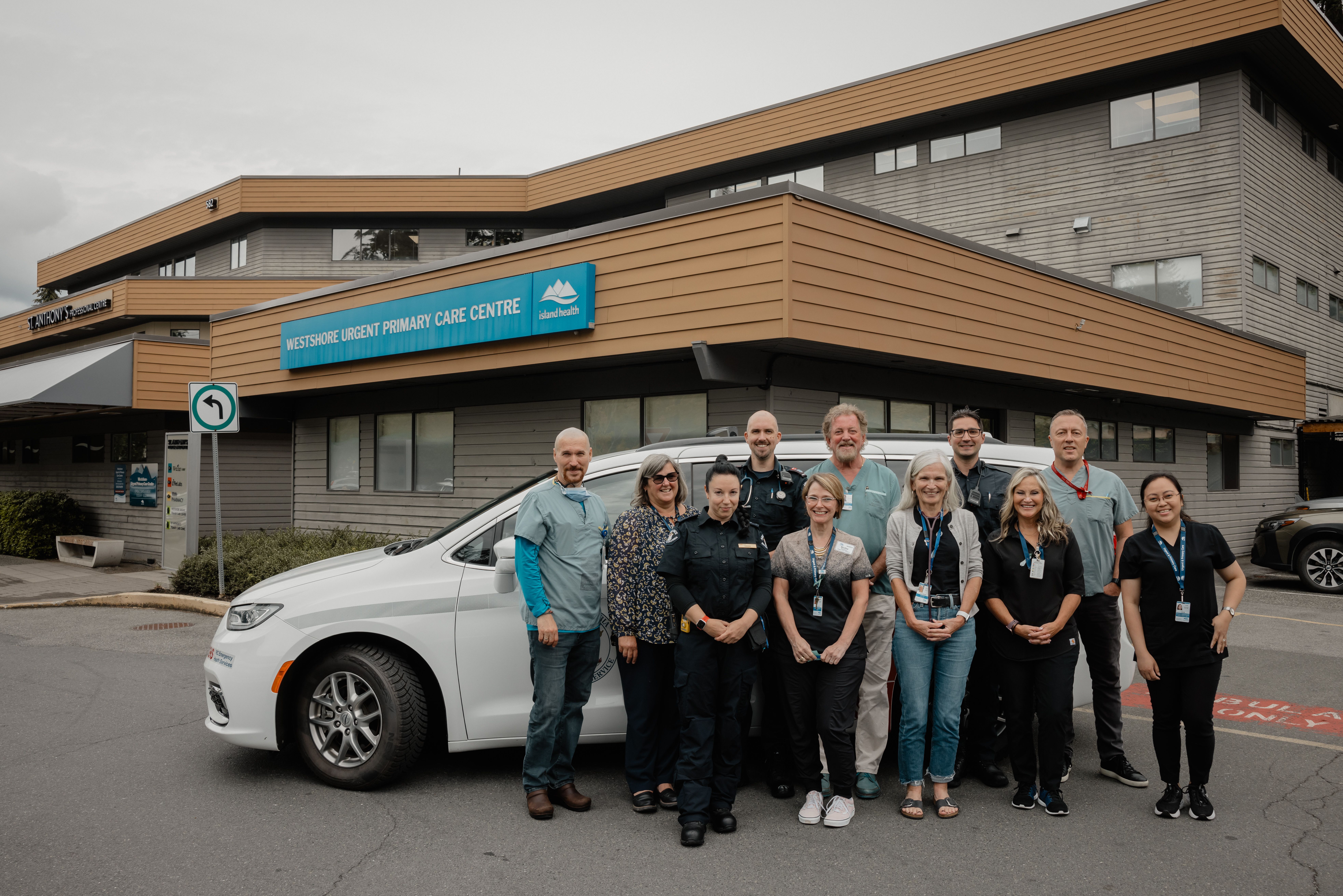A powerful new partnership between Island Health and BC Emergency Health Services (BCEHS), which oversees the BC Ambulance Service, has created alternate pathways for patients who may not require care at an emergency department (ED).
Link and Referral Units (LARUs) are single paramedics responding in minivans who specialize in assessing and treating 911 patients whose conditions are non-urgent, but do require further medical care, and may be better treated at Urgent and Primary Care Centres (UPCCs). Currently, six Victoria UPCCs have partnered with BCEHS, with ongoing discussions for partnerships in Nanaimo.

LARU paramedics and Westshore UPCC team
“The main goal for LARU paramedics is to link non-urgent 911 patients with the most appropriate care within the health care system, which may be a UPCC,” said Kayla Welwood, Manager, Low Acuity and Integrated Care, BC Emergency Health Services. “There are so many phenomenal services beyond that of emergency departments, and it only makes sense to synergize them whenever possible.”
LARU was initiated by BCEHS from one pilot unit in 2020 and has since expanded to 18 response units throughout the province, including Victoria and Nanaimo. The LARU/UPCC partnership within Island Health was initiated in May 2024 to optimize the care provided for lower acuity patients in the 911 system. This new UPCC referral partnership is available to emergency ambulances as well, when appropriate.
“Our historical response model of care was about taking patients directly to the emergency department; however, we realized that approach doesn’t serve non-emergency patients most appropriately,” said Welwood.
“Our updated response model integrates our services into the broader health care system by helping patients receive the right care in the right place. LARU paramedics allow for emergency ambulances to remain available for our most urgent patients while alternate care pathways streamline care for non-urgent patients. This has dramatically changed the 911 response model established more than 50 years ago.”
When South Island and Nanaimo patients dial 911 for the BC Ambulance Service, the call is triaged in the BCEHS dispatch centre first by Emergency Medical Call-Takers (EMCTs). The call may then be further triaged by Secondary Triage paramedics, in the dispatch centre, who might contact the patient for additional clinical information.
If the call falls within LARU response guidelines and a LARU is the most appropriate resource for the patient, a LARU paramedic is dispatched. A LARU paramedic will respond and perform a thorough clinical assessment and discuss options for care with the patient, which may include making an appointment at a UPCC and transporting the patient there for further treatment.

LARU paramedics
“It’s rewarding to be able to spend more time with patients listening to their concerns and using my skills and experience to provide thorough assessments,” said LARU paramedic, Anthony Hayer, a paramedic with 16 years’ experience. “By working with the UPCCs, we can help improve outcomes for lower acuity patients.”
“Innovation in today’s health care landscape is so important. Anything we can do to support patients and emergency departments by leveraging our resources is excellent,” said Antony Neale, a registered nurse at the Westshore UPCC. “I’d love to see the partnership expand further moving forward.”
Dr. Kimberley Cameron, a physician at the Westshore UPCC, explained how the site has the resources to support lower acuity patients.
“This program is so beneficial for providing patients with the appropriate care they need in a timelier manner,” she said. “I believe that in time, our collaboration with LARU teams can decrease the number of patients transported to emergency departments.”
Since the partnership began in May 2024, 84 patients have been transported to UPCCs in Greater Victoria. One of them was a tourist who became injured while visiting Vancouver Island and was taken to a UPCC for treatment, instead of a local emergency department. Prior to the visit, the LARU paramedic set the stage by explaining to the tourist that they would walk into the UPCC together and the paramedic would provide necessary information to UPCC staff.
“The patient had their injury assessed and treated so they could safely continue their trip without fear of infection,” said LARU paramedic, Tamara Tulloch, a paramedic with 14 years’ experience. “It was a really positive experience for them to feel like they were well supported along their unexpected medical journey. Having this pathway to the UPCCs eliminates the level of anxiety that can result from a hospital visit.”
Supporting patients through their medical journey is significant to LARU paramedics who report that they regularly receive positive patient feedback.
“Ultimately, the end goal is a better experience for the patient. This partnership allows us to work with our UPCC colleagues to determine options other than the ED and help make decisions that are beneficial for patients,” said LARU paramedic, Derek Gytenbeek, who has more than 5 years’ experience. “I really value the open and honest conversations we regularly have with UPCC staff about what we have learned and improvements that can be made to the health care system.”
“Those conversations are so important,” said Cathy Edwards, Manager, Westshore UPCC. “We have developed excellent relationships with LARU paramedics and the BC Ambulance Service with a common goal of providing our shared patients with the right care in the right place.”
As the program gains strength and momentum, care providers are considering it an important piece of the Island Health and British Columbia health care landscape.
“We are so excited to be on the ground level of this legacy building work,” said Tulloch. “It is the evolution of health care delivery and we at BCEHS are pleased to be part of the solution.”
People should continue to contact UPCCs directly to schedule appointments for non-urgent medical concerns and call 911 if they or someone in their care is experiencing a medical emergency.
